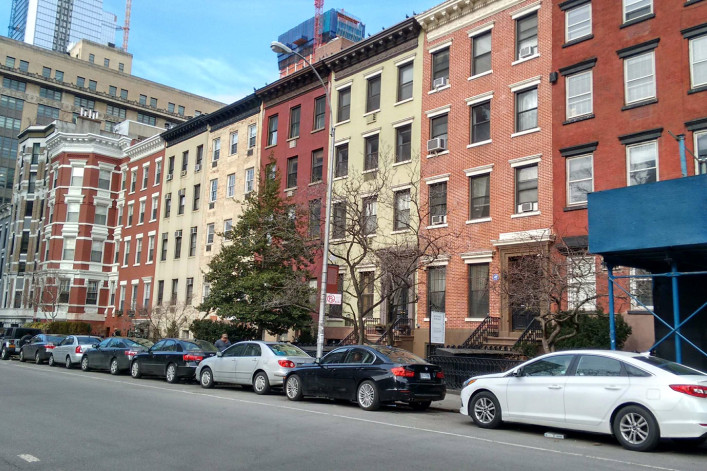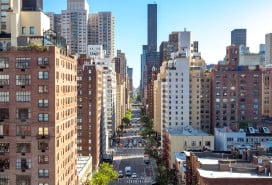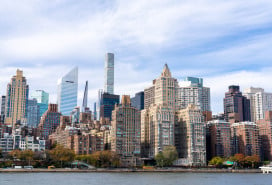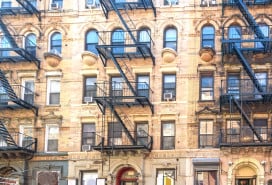Lamartine Place: A small strip of Chelsea where slaves stopped on their way to freedom

Lamartine Place disappeared from Manhattan street directories in 1898 but the block that once carried that name has ignited the passions of New Yorkers for over 150 years, from abolitionists to rioters to, of late, preservationists.
The site of historic pre-Civil War events, a Civil War riot and now a 21st century real estate battle, the Lamartine Place Historic District—just 12 houses on the north side of West 29th Street between 8th and 9th Avenues—has an amazing story to tell.
The cast of characters includes some of the city's most ardent abolitionists: Isaac Hopper, Isaac's daughter Abigail, and her husband James who had a home on the block. The Hopper-Gibbons family was in the thick of the abolitionist struggle—their home was a documented stop on the Underground Railroad—which is one of the reasons they were prime targets of the mob that terrorized New York during the horrendous Draft Riots of 1863. Below, five little-known facts about this mini-neighborhood.
1.The developers of Lamartine Place thought the name would add a little je ne sais quoi.
Developers William Torrey and Cyrus Mason built their first project in Chelsea in 1845: It was a long row of 81 townhouses for wealthy businessmen called London Terrace—you can read our Take Five on it—that extended from 23rd to 24th Street between Ninth and Tenth Avenues, according to a Lamartine Place Historic District report. Those were torn down to make room for the huge London Terrace apartment building complex that stands there now.
A year later, in 1846, Torrey and Mason bought all the land on 29th Street between Eighth and Ninth Avenues. Again, their plan was to attract the rich and famous. They chose two ways to do that: One was to create a park that ran between 28th and 29th on the eastern half of the block, facing the houses; another was to give the block its own name, something that would set it apart from the banal-sounding number names of the Manhattan grid. They dubbed West 29th, Lamartine Place.
In a column in the New York Times, architectural historian Christopher Gray wrote that it was likely named for Alphonse de Lamartine, a popular 19th century French poet and politician “identified with liberal and antislavery causes."
2. Number 17 Lamartine Place (now 339 West 29th Street) was a stop on the Underground Railroad.
James Sloan Gibbons and his wife, Abby Hopper Gibbons, first moved into 17 Lamartine Place and then next door to 18. The two were Quakers and abolitionists. She was the daughter of Isaac Hopper, who sheltered escaped slaves in his Philadelphia home. In a review of a book on Isaac Hopper, Frederick Douglass wrote about the senior Hopper: “He was the first white man I saw when escaping slavery, who led me to doubt the, till then, well established conviction that no white man could possibly possess a disinterested regard for the despised black man….”
Their home became an Underground Railroad site. “The house of Mrs. Gibbons was a great resort of abolitionists and extreme anti-slavery people from all parts of the land, as it was one of the stations of the Underground Railroad by which fugitive slaves found their way from the South to Canada," reads a letter written before the Civil War by neighbor and family friend Joseph Choate (discovered by Fern Luskin, a professor of art and architectural history at LaGuardia Community College).
When Abraham Lincoln called for 300,000 soldiers to join the Union Army in 1862, James Gibbons, an avid Republican and Lincoln supporter, wrote a poem “Three Hundred Thousand More” that became a popular patriotic song.
3. The Draft Riots of 1863 rocked Lamartine Place in the 1860’s.
The Draft Riot of July 1863, one of the most horrific episodes in New York City’s history, brought four days of looting, burning, and unspeakable violence to the city. The riot broke out just days after the Federal Government instituted the Draft Act, the first time that military service was declared compulsory in the U.S.
According to Off the Grid, the Greenwich Village Society for Historic Preservation's blog, “the draft riots reflected the the extreme racial and class tensions exacerbated by the Civil War. Working class men were in direct competition for scarce jobs with African-Americans and the Emancipation Proclamation further tied the war to the cause of slavery.” These tensions were exacerbated by the fact that the wealthy could buy their way out of the draft with a $300 payment.
During the riot, the mob set out to destroy the property of wealthy New Yorkers and anyone known to be supporters of Lincoln’s Republican party. It's no surprise, then, that the Hopper-Gibbons’ home became a target.
On the afternoon of the third day of the riots, sensing the danger, Abby and James’ daughters Julia and Lucy, along with one of their cousins, moved some of their belongings to the attic of their uncle Samuel Brown’s home nearby at 347 Lamartine Place,carrying them over the rooftops which, according to a Landmarks Preservation Commission report, were uniformly flat and even. Rioters attacked their home later that afternoon and when neighbor Joseph Choate saw smoke coming from their house, he went in to find the girls. Per the report, he located them at their uncle’s house, he led them over the rooftops, down into number 355 and then out to a carriage that was waiting on the corner of Ninth Avenue that took them to safety on West 21st Street.
The Gibbons received $8,500 from the city to rebuild their home and in 1866, when their claim with the Humboldt Fire Insurance company was settled, they sold the house and moved to a rental on West 33rd Street.
4. The property at number 355 (where the Gibbons girls made their final exit) was the Hebrew Orphan Asylum.
In 1860, the Hebrew Orphan Society moved into the four-story brick house that is now number 355. Orphan asylums were common institutions throughout the city at the time and this one was set up to house 30 orphans and half-orphans while a more permanent site was being built on the Upper East Side, according to the book, The Luckiest Orphans: A History of the Hebrew Orphan Asylum of New York.
5. Today, there's still drama—and a house on the market, too.
The present owner of the 339 West 29th Street, Tony Mamounas, began to build a rooftop addition on top of the Hopper-Gibbons home about 10 years ago. This infuriated neighborhood activists, who organized a group called the Friends of Hopper Gibbons Underground Railroad site & Lamartine Place Historic District.
Through the efforts of the Friends group and with the help of a number of local elected officials, the Landmarks Preservation Commission designated the house as part of the broader Lamartine Place Historic District in 2009. The group was hoping that would settle the problem of the rooftop addition. It didn’t and the fight continues.
As Julie Finch, co-chair of the group along with Fern Luskin, explains: “The present legal status of the fifth floor, is (that) its permit is/was invalid, and must come down.” But it hasn’t in spite of the fact that the group has “won all our appeals at Board of Standards & Appeals, and two Courts. The illegal, secretively built fifth floor addition is still there, as is its scaffolding.”
So, now what? When asked what happens to the structure that remains in place on the top of the building, a spokesperson for the Department of Buildings told us in an email that it is the "responsibility of a property owner to ensure their building is maintained in a safe and code- compliant manner at all times. The failure to do so can result in violations, as was the case at this site where they performed work outside the scope of the approved plans." And if the conditions are deemed hazardous to the public, the DOB can issue an emergency declaration, calling in the city's contractors (at the expense of the owner). But, "the existing structure has not been determined to pose an immediate threat to public safety," he says.

If you’d like to live two doors down from the Hopper- Gibbons home (and in a much less controversial property), it'll cost you $7.995 million to buy 343 West 29th Street (shown above), complete with an “owner’s duplex” with three bedrooms, two-and-a-half baths and a bi-level backyard space; the building has three other two-bedroom apartments that rent at free market rates.
And according to the New York Post, Ellen Burstyn considered renting the 2,400 square foot duplex in 2013 when the rent was $11,000.
Is there a building or neighborhood you've always wanted to learn more about? Email us at [email protected] and we'll find out more for you.
Related:
The Rhinelander District: A tiny slice of the Upper East Side that Andy Warhol called home
The history behind Grand Concourse, the "Champs-Elysee of the Bronx"
5 things you didn't know about Jamaica Estates, Trump's former home in suburban Queens
Wallabout: 5 things you probably didn't know about one of Brooklyn's most interesting streets




























